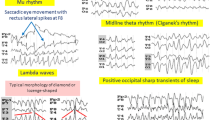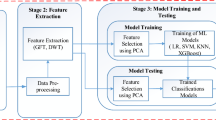Abstract
We discuss a model for the dynamics of the primary current density vector field within the grey matter of human brain. The model is based on a linear damped wave equation, driven by a stochastic term. By employing a realistically shaped average brain model and an estimate of the matrix which maps the primary currents distributed over grey matter to the electric potentials at the surface of the head, the model can be put into relation with recordings of the electroencephalogram (EEG). Through this step it becomes possible to employ EEG recordings for the purpose of estimating the primary current density vector field, i.e. finding a solution of the inverse problem of EEG generation. As a technique for inferring the unobserved high-dimensional primary current density field from EEG data of much lower dimension, a linear state space modelling approach is suggested, based on a generalisation of Kalman filtering, in combination with maximum-likelihood parameter estimation. The resulting algorithm for estimating dynamical solutions of the EEG inverse problem is applied to the task of localising the source of an epileptic spike from a clinical EEG data set; for comparison, we apply to the same task also a non-dynamical standard algorithm.




Similar content being viewed by others
References
Akaike H (1974) Markovian representation of stochastic processes and its application to the analysis of autoregressive moving average processes. Ann Inst Stat Math 26:363–387
Akaike H (1974) A new look at the statistical model identification. IEEE Trans Automat Contr 19:716–723
Akaike H (1980) Likelihood and the Bayes procedure. In: Bernardo JM, De Groot MH, Lindley DU, Smith AFM (eds) Bayesian statistics. University Press, Valencia (Spain), pp 141–166
Akaike H, Nakagawa T (1988) Statistical analysis and control of dynamic systems. Kluwer, Dordrecht
Ary JP, Klein SA, Fender DH (1981) Location of sources of evoked scalp potentials: corrections for skull and scalp thickness. IEEE Trans Biomed Eng 28:447–452
Baillet S, Mosher JC, Leahy RM (2001) Electromagnetic brain mapping. IEEE Sign Proc Mag 18:14–30
Bollerslev T (1986) Generalized autoregressive conditional heteroskedasticity. J Econ 31:307–327
Deistler M (2006) Linear models for multivariate time series. In: Schelter B, Winterhalder M, Timmer J (eds) Handbook of time series analysis. Springer, Berlin, Heidelberg, New York, pp 283–308
Dennis JE, Schnabel RB (1983) Numerical methods for unconstrained optimization and nonlinear equations. Prentice Hall, Englewood Cliffs
Durbin J, Koopman SJ (2001) Time series analysis by state space methods. Oxford University Press, Oxford
Engle RF (1982) Autoregressive conditional heteroskedasticity with estimates of the variance of UK inflation. Econometrica 50:987–1008
Freeman WJ (2000) Neurodynamics: an exploration in mesoscopic brain dynamics. Springer, Berlin, Heidelberg, New York
Galka A, Yamashita O, Ozaki T, Biscay R, Valdés-Sosa PA (2004a) A solution to the dynamical inverse problem of EEG generation using spatiotemporal Kalman filtering. NeuroImage 23:435–453
Galka A, Yamashita O, Ozaki T (2004b) GARCH modelling of covariance in dynamical estimation of inverse solutions. Phys Lett A 333:261–268
Grave de Peralta Menendez R, Gonzalez Andino SL, Morand S, Michel CM, Landis T (2000) Imaging the electrical activity of the brain: ELECTRA. Hum Brain Map 9:1–12
Hansen PC, Jacobsen BH, Mosegaard K (2000) Methods and applications of inversion, volume 92 of lecture notes in earth science. Springer, Berlin
Jazwinski AH (1970) stochastic processes and filtering theory. Academic Press, San Diego
Kalman RE, Falb PL, Arbib MA (1969) Topics in mathematical system theory. International series in pure and applied mathematics. McGraw-Hill, New York
Kitagawa G, Gersch W (1996) Smoothness priors analysis of time series. Springer, Berlin, Heidelberg, New York
Lopes da Silva FH, Hoeks A, Smits H, Zetterberg LH (1974) Model of brain rhythmic activity, the alpha-rhythm of the thalamus. Kybernetik 15:27–37
Mazziotta JC, Toga A, Evans AC, Fox P, Lancaster J (1995) A probabilistic atlas of the human brain: theory and rationale for its development. NeuroImage 2:89–101
Neumaier A (1998) Solving ill-conditioned and singular linear systems: a tutorial on regularization. SIAM Rev 40:636–666
Nunez PL (1981) Electrical fields of the brain. Oxford University Press, New York
Pascual-Marqui RD (2002) Standardized low resolution brain electromagnetic tomography (sLORETA): technical details. Methods Find Exp Clin Pharmacol 24D:5–12
Pascual-Marqui RD, Michel CM, Lehmann D (1994) Low resolution electromagnetic tomography: a new method for localizing electrical activity in the brain. Int J Psychophysiol 18:49–65
Riera JJ, Fuentes ME, Valdés PA, Ohárriz Y (1998) EEG-distributed inverse solutions for a spherical head model. Inverse Probl 14:1009–1019
Robinson PA, Rennie CJ, Rowe DL (2003) Estimation of multiscale neurophysiologic parameters by electroencephalographic means. Hum Brain Map 23:53–72
Schwarz G (1978) Estimating the dimension of a model. Ann Stat 6:461–464
Sotero RC, Trujillo-Barreto NJ, Iturria-Medina Y, Carbonell F, Jimenez JC (2007) Realistically coupled neural mass models can generate EEG rhythms. Neural Comput 19:478–512
Wong KFK, Galka A, Yamashita O, Ozaki T (2006) Modelling non-stationary variance in EEG time series by state space GARCH model. Comput Biol Med 36:1327–1335
Yamashita O, Galka A, Ozaki T, Biscay R, Valdés-Sosa PA (2004) Recursive penalized least squares solution for the dynamical inverse problem of EEG generation. Hum Brain Map 21:221–235
Acknowledgments
The work reported in this paper was supported by the Japanese Society for the Promotion of Science (JSPS) through fellowship ID No. P 03059 and grants KIBAN B No. 173000922301 and WAKATE B No. 197002710002. The first author is grateful to Matthew Barton and Peter Robinson for useful discussions.
Author information
Authors and Affiliations
Corresponding author
Rights and permissions
About this article
Cite this article
Galka, A., Ozaki, T., Muhle, H. et al. A data-driven model of the generation of human EEG based on a spatially distributed stochastic wave equation. Cognitive Neurodynamics 2, 101–113 (2008). https://doi.org/10.1007/s11571-008-9049-x
Received:
Accepted:
Published:
Issue Date:
DOI: https://doi.org/10.1007/s11571-008-9049-x




